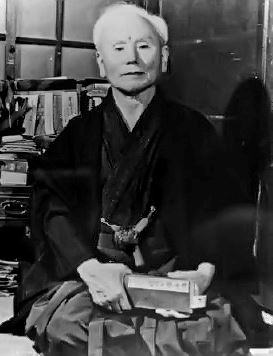 |
| An iconic picture of sensei Gichin Funakoshi (http://tinyurl.com/3krbd32) |
Every time a karate student kicks, or steps forward into karate stance, they are transported back to the 1920s, a time when karate was unknown outside of Ryu Kyu, let alone outside of Japan. It was a peasant’s sport, and it was taught only by masters who lived on the island of Ryu Kyu. Times have changed, and 90 years later, karate classes are common and loved all over the world. Also, who hasn't seen the 1984 hit, "The Karate Kid"? So, how did karate go from being a peasant’s only defense to a household name? We can thank Gichin Funakoshi for that.
Though the definite origin of karate is unknown, it is strongly believed that it was created by Buddhist monks in India over 1,500 years ago, as a way of defending themselves without using weapons as to not disrespect their religion. Keep in mind that this is the very baby of modern day karate, so the monks wouldn’t be practicing something as refined as we practice today. By the 1600s, it had made its way over to the Ryukyu islands, which are now called Okinawa, and was practiced and refined by its citizens. Ryukyu was comprised of peasants that couldn’t afford, or were permitted by the Japanese government, to buy things such as samurai swords to defend themselves with, so using an empty hand and farming tools, they created karate. Up until the 1900s, karate was unknown to those outside of Ryukyu, It made its debut in 1917, Tokyo, Japan, when it was shown to the Japanese Ministry of Education by my hero, Gichin Funakoshi.
In 1868, Gichin Funakoshi was born in Ryukyu. From when he was a young boy, he was taught by two masters two different styles of karate. From Yasutsune Azato he learned Shuri-te, and from Yasutsune Itosu he learned Naha-te. He melded these styles together to create and refine the style that I practice, Shotokan. He worked as a teacher’s assistant in Ryu Kyu, teaching children karate as a physical education. In 1917, Gichin ventured to the vastly larger, wealthier, more populous mainland: Tokyo, Japan. The Japanese Ministry of Education invited him to be a part of a exhibition for physical educators. One would assume that a peasant from the poorest prefecture in Japan performing a martial art he created would be laughed off, ignored by the intimidating officials that came out on top of a city that, in its most minuscule detail, blew the mind of Gichin Funakoshi. Instead of being shrugged off, he was invited back to Tokyo in 1922, and again, for a third time, a few years after that to present his martial art, Shotokan Karate, to the royal family. After his display to the royal family, Sensei Funakoshi remained in Tokyo to teach and raise awareness about Shotokan. Not long after, Gichin got the world kicking and punching and “KI-AI!’’ing.
Sensei Funakoshi died in 1957 at the age of 88. Though his life was not particularly long, his legacy was grand and will be remembered always. As well as teaching his own variation of an unknown art to a much more powerful mainland, he also wrote 2 books. An autobiography, “Karate-Do: My Way of Life” and “Karate-Do Kyohan”, the ultimate, shotokan handbook. His books reflect his gentle, knowledgeable personality and defined his great legacy.
Gichin Funakoshi is a hero, because he had the bravery to, as a peasant, show his art to the officials in Japan, and was able to take all the violence out of a contact sport. He taught peace through his actions, and made other people do the same. So many are proud to call shotokan their sport, and Sensei Funakoshi would be proud to see that millions of people feel that way. With shotokan, he has taught karate students everywhere to be respectful, disciplined and peaceful yet strong. Shotokan brings out the best in everyone, and any Shotokan Black Belt believes that everyone should be able to experience what they have with karate. In Gichin’s words, “I practice peace through my actions. The ultimate aim of Karate lies not in victory or in defeat, but in the perfection of the character of its participants"
Page created on 10/24/2011 12:00:00 AM
Last edited 9/11/2018 5:53:12 AM
